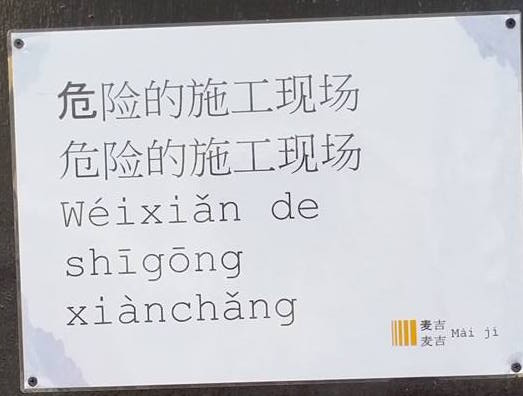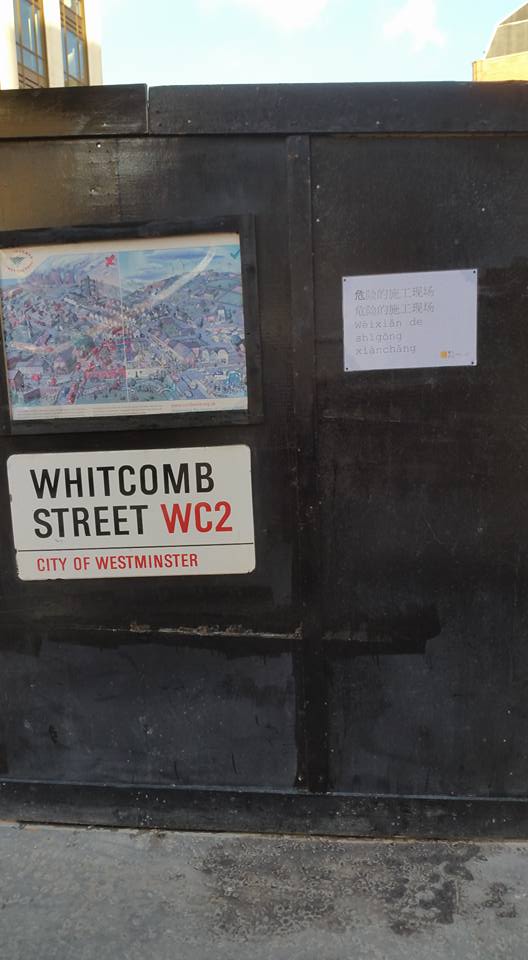Intriguing Chinese sign spotted in London
« previous post | next post »
From Donald Clarke:
The sign seems straightforwardly to be a warning that this is a "dangerous construction site". The more you look at it, however, the more questions arise.
Why is the Chinese repeated?
Did they mean to present it in traditional characters too? 危險的施工現場
Why is the first character in bold?
This treatment of the Chinese recurs in the signature at the bottom right: repeated in simplified characters with the first character in bold. Mak6 Gat1 (I'm guessing that it's a Cantonese name, since 麦 / 麥 is a common surname among Cantonese speakers.)
To whom is the sign addressed?
Why did they include the careful (with tones and word spacing) Pinyin?
People who are only familiar with Mainland MSM will think that the second tone of the first character (危) is wrong, because the standard for Putonghua in the PRC is first tone, but the standard for Guoyu on Taiwan is second tone, and that is how I learned it half a century ago.
So, upon closer examination, the superficial simplicity of the sign soon breaks down.
The puzzles multiply when the printed sign is viewed in its context next to an inscrutable painting affixed to the left of the sign on the wall:
Are the sign and the painting in dialog with each other?
Is there some sort of deeper message being conveyed here? A cultural or political protest?
Perhaps someone across the pond could pop over to Whitcomb Street WC2 in the City of Westminster and take a peek around, maybe even ask some questions of the locals, to find out more about what's going on.


Tom S. Fox said,
November 15, 2016 @ 4:22 pm
The “painting” is clearly a map.
Bruce Stephens said,
November 15, 2016 @ 4:33 pm
It's visible on Google Maps Street View (the map and the Whitcomb Street sign, but the Chinese notice doesn't seem to appear). I see this at the junction of Panton Street and Whitcomb Street, and Street View says "35 Panton St." and is from May 2016
John Swindle said,
November 15, 2016 @ 5:00 pm
Thanks to Bruce Stephens for the street view. The "THINK SAFETY" sign to the left of the painting identifies the demolition firm McGee, which makes the painting theirs. 麦吉 is a way to write "McGee." Their website mcgee.co.uk identifies this as their Leicester Square project and has further information. The Chinese sign remains a puzzle.
Candida said,
November 15, 2016 @ 5:22 pm
Just a theory, but Whitcomb St. is right near Chinatown, so that could have something to do with it.
John Swindle said,
November 15, 2016 @ 6:50 pm
Or, rather, the unusually worded and duplicated and pinyinified Chinese warning sign is McGee's, since their name and logo appear on it. Professor Mair's conjecture that they were trying for simplified and traditional characters is plausible. They thought changing fonts would do the trick, but it didn't. And the painting may be an artist's representation of two stages of the demolition project.
Simon P said,
November 16, 2016 @ 1:19 am
Using 麥/麦吉 for "McGee" is in itself rather interesting, as I believe it mixes Mandarin and Cantonese transcription.
Using 麥/麦 for "Mc/Mac" as in McDonald's or any Scottish clan name is clearly of Cantonese origin, since the Cantonese reading of this is "mak6" whereas the Mandarin is "mai4".
The 吉 as a transcription for "Gee", however, is clearly Mandarin, as the Cantonese reading of this character is "gat1" and the Mandarin is "ji2".
(I'm not saying the company itself mixed it, rather, they used an old convention of rendering "Mc" as 麥/麦.)
Rodger C said,
November 16, 2016 @ 7:48 am
@Simon P: Do you not pronounce "McGee" with /g/? This puts both Chinese readings off.
Daniel said,
November 16, 2016 @ 1:02 pm
@Rodger C.: The syllable [gi] isn't found in either Mandarin or Cantonese, so they're doing their best.
It appears some transliterate "Mc" as 麦克 mai4ke4, but most still stick to just 麦 mai4.
flow said,
November 17, 2016 @ 3:33 am
@Simon P, Rodger C—"Do you not pronounce "McGee" with /g/?" It's anybody's guess whether t'is nobler in the mind to suffer MSM ji for English /gi:/, or, alternatively, MSM ge for the same; they're both way off.
History seems to tell us that often renderings become accepted that are not optimally sound-alike; to me one classic example is MSM kangde 康德 kangde for the German name Kant—which could have been rendered as 看特 kante (much closer to the original), but wasn't.
George said,
November 17, 2016 @ 7:45 am
@Simon P
I don't read Chinese but I lived briefly in Beijing and McDonalds (patronised on occasion for the cleanliness of its sanitary facilities rather than for the desirability of its menu) was Mai Dong Lao.
julie lee said,
November 17, 2016 @ 2:15 pm
@flow:
I disagree. 康德 "kang de" (in Pinyin romanization) for Kant is closer to the German vowel "a" than 看特 "kan te" . Pinyin "kang" rhymes with English "kahng", whereas "kan" rhymes with English "can".
K. Chang said,
November 18, 2016 @ 1:36 am
I found something similar but this is a blast from the past:
Someone recently brought up the Chinese on the unit patch of US Navy submarine USS Seadragon SSN 584
http://www.ussseadragonssn584.org/
Which says: 從海的底我條規 (Cóng hǎi de dǐ wǒ tiáoguī) (From sea's bottom I regulations)
Turns out it was supposed say "From the depths I rule" in Chinese. (You can see that just under the title at the Alumni page. )
Wonder who designed the unit patch and how did it get the Chinese?
Brandon Seah said,
November 19, 2016 @ 2:38 am
Following up on John Swindle's comment above – my guess is that someone prepared it on one computer with both simplified and traditional fonts, and then sent the file to someone else for printing, but the latter did not have a traditional font and so the closest font(s) was automatically subsituted instead, which might explain why the first line has the first character looking different.
It reminded me of what happens sometimes when one browses a Chinese webpage on a computer that has only two or three default bare-bones CJK fonts installed. If a character comes up in a line of text that is missing from the intended font family, the equivalent from the next font will be substituted if available.